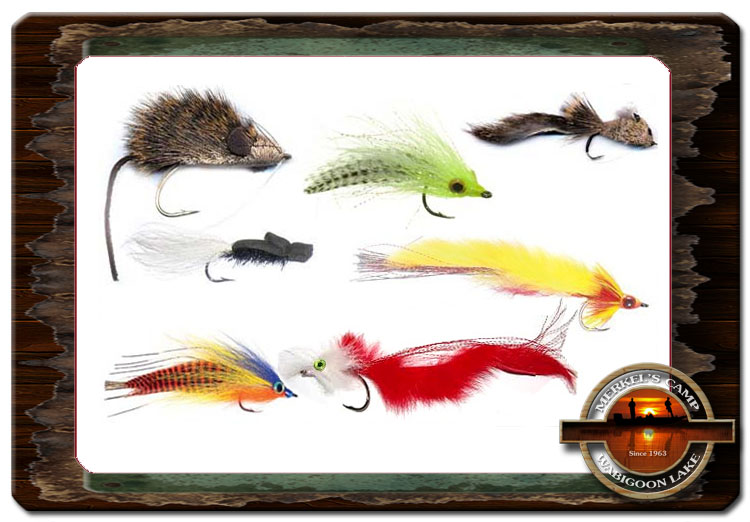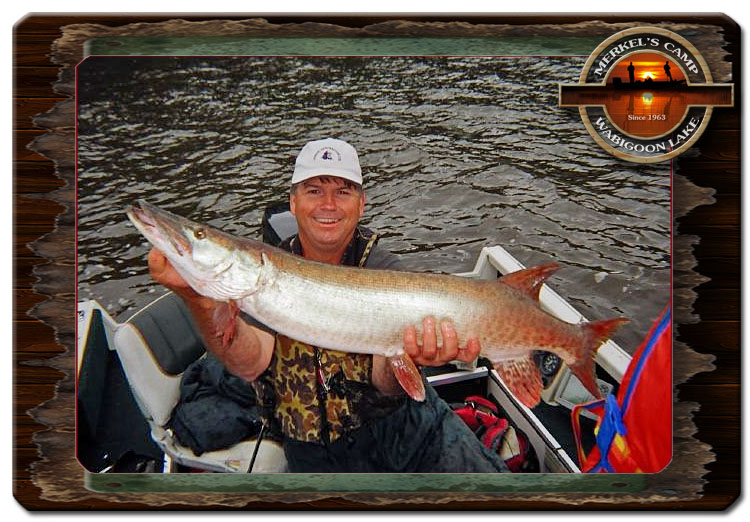



The tips below are taken from an article from Scott E. Smith's book, The Ontario Blue-Ribbon Fly Fishing Guide, which is available for sale on eBay and Amazon
Although musky are represented quite well in most southern areas of the province, and pike virtually everywhere in the province, I have chosen to focus on Northwestern Ontario as the place for pike and musky of monstrous proportions. Wabigoon has potential world-record size musky in its waters. In fact, Wabigoon Lake, which is situated along the Trans-Canada Highway near the towns of Dryden and Wabigoon, was the site of a biological study on musky in which two muskies exceeding the present world record of approximately seventy pounds were netted and photographed by biologists in the late 1980s. (One musky was conservatively estimated at eighty pounds by one of the project's biologists.) This occurrence, in addition to the fact that I grew up in Dryden fishing the waters of Wabigoon Lake, brought me back to the area to fish in waters that perhaps held the new world-record musky. And I could attain instant fame by catching it on a fly rod!
I fished with high school friend Terry Kluke who now owns and operates Merkel's Fishing Camp on Wabigoon Lake near Wabigoon, Ontario. Terry began his most hospitable guiding foray, that lasted about three days, by showing me the famous photo of the two gargantuan musky over seventy pounds inside a large net on a small aluminum boat. Terry, in fact, assisted in the study, by pointing out to the biologists the haunts of large musky in the area. Terry's knowledge of the lake proved invaluable to the biologists whose study involved capturing, tagging and monitoring the travels and habits of large musky. In addition to the "record" fish that were captured (incidentally they were not tagged due to the fact that the biologists could not physically hang on to them long enough), numerous fish in the forty- to sixty-pound range were netted, fitted with transmitters and monitored over several summers. In addition to the spectacular find of truly enormous musky in the lake, the five-year study showed these large musky had several haunts that they frequented routinely by traveling well-defined routes from bay to bay. As a result of the findings of this study, and from lobbying by lodge owners such as Terry Kluke, the limit on musky was set at one fish per day over 52 inches (two fish in possession). This regulation has greatly benefited the musky population in the lake, as well as the trophy fishing industry in the area. Terry Kluke's paternal commitment to the restoration of the Wabigoon's giant musky and his extensive knowledge of these routes and haunts makes him the ultimate musky guide. Terry also showed me photographs of a northern pike (about sixteen pounds) that had been mauled by a large musky while being fought by one of Terry's guests who was casting from the camp dock. The pike was photographed and released; who knows what fate awaited it in the waters near Merkel's Camp. These photos, and stories about full-grown ducks disappearing from the surface in tremendous boils, add to the folklore of fishing this beautiful area. As we cruised out from Merkel's dock on the first day of musky fishing, I mulled over the accounts that Terry had so eloquently detailed until I finally looked at him and asked, "Do you know where the baby muskies hang out?"
We made several outings over the next three days but failed to click onto a good musky, although we were kept nicely entertained by numerous tenacious pike. We had been plagued by wind and very hot weather. But as Terry points out, "You don't fish for musky, you hunt, and we've only been hunting a few days." One very interesting technique Terry employs is reminiscent of deep-sea marlin fishing. Terry methodically works one of several large twelve inch plugs in his box, complete with hula skirts and propellers, on a stout bait-casting outfit, while the client(s) fly cast to likely holding water. He does this to tease the musky or wake them up, as he puts it-and get them following the plug. Once this occurs the client can deliver a well placed fly right in front of the cruising musky and hopefully elicit a strike from the fish.
Large musky feed infrequently on large prey, such as three- to five pound walleye and whitefish; subsequently when these huge fish are not feeding they must be irritated into striking with large, noisy baits and flies incorporating flashy colours, rattles and erratic actions.
Wabigoon Lake is a unique body of water. It is a large, fairly shallow, clay-bottomed lake with inherently murky water; fishing it one hot summer evening I imagined myself fishing in a bayou somewhere.
Although non-typical fly-fishing conditions, the richness of this system provides for an abundance of aquatic life. Tremendous hatches of large mayflies, locally referred to and disdained as "fish flies", account ultimately for the existence of trophy musky and pike.
Now before you begin to conjure up thoughts of fishing for musky with a White Wulff, these brutes naturally do not focus on the hatches for sustenance. What these prolific hatches do for the fishery though, is provide the forage base for large populations of whitefish, lake herrings, walleye, perch and bass that in turn become abundant fare for musky and pike. Whitefish especially are a favored food of musky and pike. Referencing Schwiebert's Matching the Hatch, considering the size and coloration of these "fish flies", and Wabigoon's silt-bottomed waters, the primary hatches are likely Hexagenia recurvata, Hexagenia limbata and Ephemera simulans.
Wabigoon Lake is maze-like with numerous bays and islands; there are a multitude of shallow coves and bays with thick groves of weeds, providing ideal habitat for musky and pike. On occasion musky can be seen "sunning themselves" on the surface of these weed beds. A good fly caster can plop a fly on the edge, or in a pocket of, a weed bed. Often if there is a pike or musky there they will immediately take the fly.
Given the size of the lake, the numerous islands and bays, and abundance of shallow rock reefs-invisible because of the murky water-fishing without a guide is not recommended. Naturally I give Terry Kluke the thumbs up as a musky guide. His personal best is a 48-inch musky that he released; in fact no musky have been killed at Merkel's Camp since 1980. The Camp record is a whopping 60-inch fish.

1) The most important part of your cast is the retrieve. Fly fishermen are so used to picking up yards of line to ready the next cast. For Muskies, 6 of 10 strikes are right beside the boat. You always hear fisher people preach the figure "8". It is a little harder with a fly rod. 9-12 weights make the figure “8" easier. Remember to always bring your fly right to the boat. A simple L or J motion with your rod along with a little pause will almost always entice those big toothy critters to bite.
2) Be sure to position yourself if possible so you are not casting with the sun at your back. These fish like to come up under their prey. They will be shallow and your shadow of the cast and retrieve will definitely deter them. 3) The use of poppers are a great attractor for shallow feeding muskies. 4) When using streamers or flies, tap the water a couple of times. Place these close to the area of your cast.
5) A big mistake people make is not spending enough time in an area. Make sure you spend time in a juicy area. It may take a few casts to get that big muskie interested.
6) If you find an area with 1 muskie, you can bet your fishing gear there will be at least one more in the area. Remember they call it "musky hunting" so try to locate their favourite spots.
7) Use at least a 9 weight rod. You need backbone to set the hook. Muskies have a very hard mouth. I love my 12 weight Sage with LX 4.5 Islander reel!
8) Be sure to keep the tension on the line, let the rod do the work. Muskie are notorious for spitting out the hook. You usually only have 1 hook on your lure, not 9 like traditional muskie baits. So keep it tight.
9) Use at least a 30-40 pound flora carbon tipet with a 60-80 flora carbon bite leader. Due to the size of the line and to keep the knots as small as possible, I put a little dab of super glue on the knot. This will make you a happy angler when you land the fish of your life.
10) Keep your boat as clean as possible to allow yourself room to move about during the fight.
11) A lure retriever is worth its weight in gold, when fishing in the rocks and timber. It will